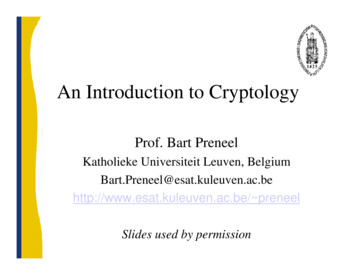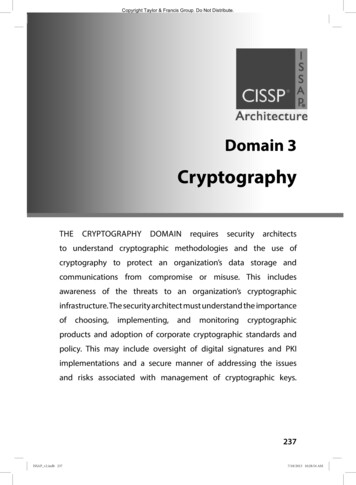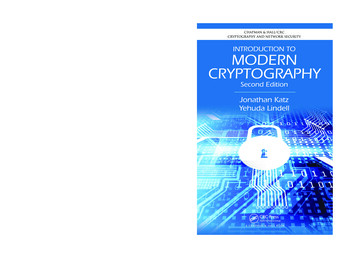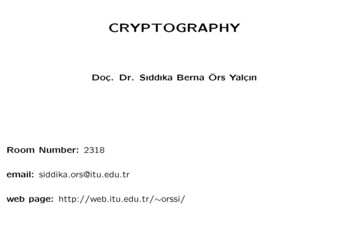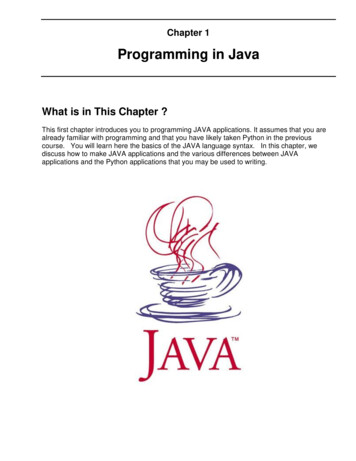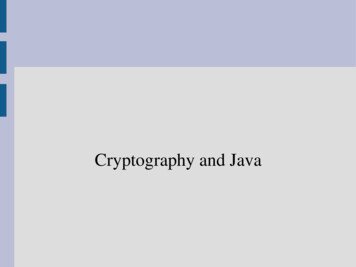
Transcription
Cryptography and Java
Cryptography and JavaJava provides cryptographic functionality usingtwo APIs: JCA – Java Cryptography Architecture– security framework integrated with the core Java APIJCE – Java Cryptography Extension–Extensions for strong encryption (exported after2000 US export policy)
Basic Architecture Provider based .providerZ
Design principles Algorithm independence– Algorithm extensibility– easy updation of engine classes with newalgorithmsImplementation independence– specification of engine classesuse of cryptographic service providersImplementation interoperability–providers working with each other
Engine classes Cryptographic operations are classified intoclasses in JCA/JCE. This classes are calledas engines.––JCA enginesJCE engines
JCA engines MessageDigest (produces hash value)Signature(produces digital signature)– KeyPairGenerator (produces pair of keys)KeyFactory (breaks down a key)KeyStore(manages and stores keys)SecureRandom(produces random numbers)– AlgorithmParameters(encoding and decoding)– AlgorithmParameterGenerator(generates parameters)CertificateFactory(public key cert, revocation)CertPathBuilder (establish relationship chains between certs)CertStore(stores certificates and revocation lists)
JCE engines Cipher (encryption/decryption) KeyGenerator (produces secret keys used by ciphers) SecretKeyFactory (operates on SecretKey objects) KeyAgreement (key agreement protocol) Mac (message authentication code functionality)
Location JCA engines are located in java.securitypackageJCE engines are located in javax.cryptopackage
Getting started Example 1: Generate a DES/AES key anduse cipher to encrypt a message.byte[] message "I am a superman, sshhh don't tell anyone".getBytes();KeyGenerator keygenerator KeyGenerator.getInstance("DES");SecretKey desKey keygenerator.generateKey();Cipher desCipher Cipher.getInstance("DES/ECB/PKCS5Padding");// Initialize the cipher for encryptiondesCipher.init(Cipher.ENCRYPT MODE, desKey);// Encrypt message and returnbyte[] encryptedMessage desCipher.doFinal(message);
Example 2: Generate random bytes usingSecureRandom.import java.security.SecureRandom;public class Main {public static void main(String[] argv) throws Exception {SecureRandom secRandom Seed(711);byte[] bytes new byte[20];secRandom.nextBytes(bytes);}}
Your Best Friend Look up API docs for the relevant packages–– java.securityjavax.cryptoJCA reference security/CryptoSpec.html
Appendix
Algorithmextensibility exampleMessageDigest ultrafastlmplementation MessageDigest.getInstance("UltraFastHash");
Implementation independence Offers the developer a choice of how tohandle the presence of providersMessageDigest Dev1Md5Implementation MessageDigest.getlnstance("MD5", "Provider1");
Implementation interoperability Providers are interoperableThe developer might use provider A togenerate a key pair, passing that key pairalong to provider B's signature algorithm
Adding providersThere are two ways Adding statically Adding dynamicallyStatic addition:–––Copy the JCE provider JAR file to java home/jre/lib/ext/Stop the Application ServerEdit the 'java home/jre/lib/security/java.security' properties file in anytext editor. Add the JCE provider you’ve just downloaded to this file.security.provider.n provider class name
Adding providersStatic addition (cont.)security.provider.2 org.bouncycastle.jce.provider.BouncyCastleProvider Dynamic addition// create a provider objectProvider bountyProvider new ();// Add the bountycastle Provider to the current list of// providers available on the system.Security.addProvider (bountyProvider);
Cryptography and Java Java provides cryptographic functionality using two APIs: JCA - Java Cryptography Architecture - security framework integrated with the core Java API JCE - Java Cryptography Extension - Extensions for strong encryption (exported after 2000 US export policy)


